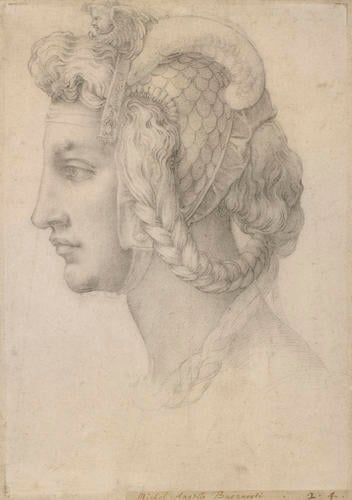-
1 of 253523 objects
An ideal female head c. 1540
Black chalk | 33.2 x 23.5 cm (sheet of paper) | RCIN 990432
-
A black chalk drawing of an ideal female head in left profile, with an elaborate headdress.
This is an accurate copy after a drawing by Michelangelo in the British Museum (1895,0915.493), one of a number of teste divine (ideal heads) drawn by the artist, mostly in the 1520s. Three of these were given to Gherardo Perini (see RCIN 990419, 991365), though the original of the present drawing cannot be traced to his possession: it was bought from Casa Buonarroti by Jean-Baptiste-Joseph Wicar, but it seems unlikely that Michelangelo would have retained it in his Florentine studio, and it was presumably a later acquisition by one of his descendants.
The subject of the drawing (if it has one) might be the Virgin or a saint, as suggested by the cherub headdress. It was etched by Antonio Tempesta in 1613, as a supposed portrait of Michelangelo’s close friend Vittoria Colonna, Marchioness of Pescara, though it bears no resemblance to her. Tempesta also etched, as a pair, another of Michelangelo’s ideal heads, the so-called Count of Canossa (the original of which is lost), and it is possible that Michelangelo intended the two original drawings as a pair.
The present copy was dated ‘relatively late’ by J. Wilde (Popham & Wilde 1949, no. 455); P. Joannides (Michelangelo and his Influence, London 1996, no. 2) preferred a date around 1540, and suggested the copyist might be the same hand as the British Museum’s copy of the Count of Canossa (1895,0915.492). It is most probably the work of an artist in the circle of Bronzino, around the middle of the sixteenth century.
On a strip of paper attached to the bottom of the sheet is an inscription Michel.Angollo Buonaroti, 2.4 (the 2 changed from a 1), in the hand associated with the seventeenth-century dealer William Gibson, whose inscriptions and characteristic ‘price codes’ can be found on at least 51 drawings in the Royal Collection. Jonathan Richardson the Elder explained Gibson's pricing system, whereby the second figure is the unit - 1 for a shilling, 2 for half a crown, 3 for a crown (5 shillings) and 4 for a pound (20 shillings). A price code of 2.4 would indicate that the drawing was priced at two pounds, a high price (in fact the highest of any Gibson drawing in the Royal Collection) that indicates the drawing was believed to be an original Michelangelo at that time - indeed few original drawings by Michelangelo had reached England by the seventeenth century. It is likely that all these Gibson drawings were acquired for the Royal Collection during the reign of Charles II.
Provenance
From the collection of William Gibson; probably acquired by Charles II. Listed in George III's Inventory A, c.1800, p. 43, 'Mich: Angelo Buonarroti' Tom. I: ‘7. Head, as large as Life….Of the School of M. Ang:'.
-
Creator(s)
Acquirer(s)
-
Medium and techniques
Black chalk
Measurements
33.2 x 23.5 cm (sheet of paper)
Category
Object type(s)
